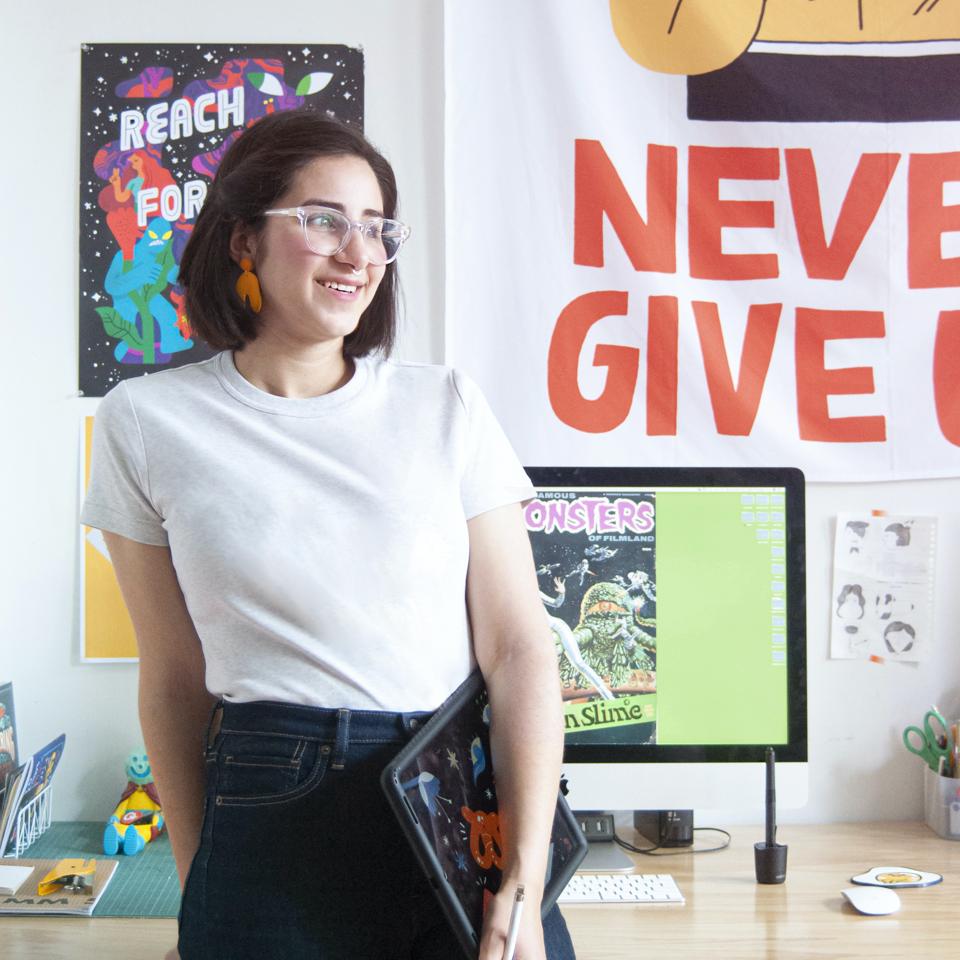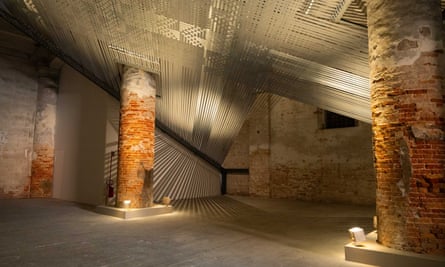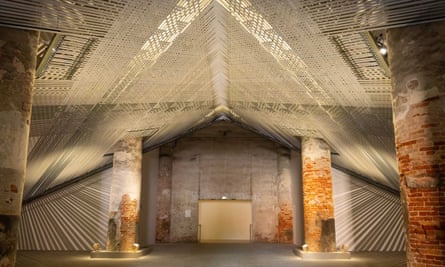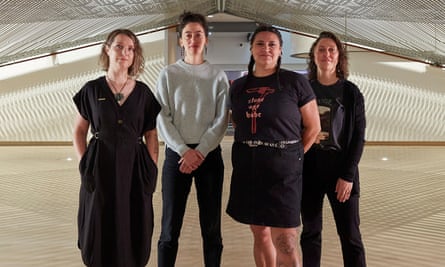Art
Collective Arts Brewing Seeks Art For New Can Series – Forbes

An artist paints a wall for Collective Arts Brewing in Hamilton, Ontario
Photo by Collective Arts Brewing
“Our brand can be encompassed in three short words,” says Matt Johnston, co-founder and CEO of Collective Arts Brewing in Hamilton, Ontario. “Creativity, community, and leadership.”
Founded in 2013, the 60,000-barrel-per-year brewery made a name for itself with its “art series,” which sees the brewery feature the work of over 200 emerging artists every year.
Combined with technically excellent beer, Collective Arts has become one of the fastest-growing breweries in North America. Today, around 150 people work for the brand, which plans on launching a US CBD portfolio and a Canadian cannabis brand later this year.
Over the past seven years, even as new employees joined Collective Arts and the product line and artist roster expanded, the company stayed true to their core values. Most recently, these values took the form of a call for art from historically marginalized voices, whose thought-provoking art will be featured across the fifty or sixty SKUs which will debut in January 2021.
“Inherent in our values is inclusivity and equality,” says Johnston. “You can’t have a creative world without inclusivity and equality. You can’t have a community.”
The call for art, which is “specifically geared toward art dealing with the issues of social justice,” invites “any artist, from any medium, anywhere in the world” to submit, and is open until August 31st, 2020. Like the brewery’s other series, finalists will be chosen by an independent group of curators.
What Is Collective Arts Brewing?


Collective Arts Brewing in Hamilton, Ontario
Photo by Collective Arts Brewing
Collective Arts Brewing was founded in Hamilton, Ontario, in 2013 by Matt Johnston and Bob Russell. However, as Johnston says, “There are really four of us I’d describe as partners in the business — myself, Russell, brewmaster Ryan Morrow, and Jeff Tkachuk, who leads all of our finance and operations.”
Together, Johnston, Russell, Morrow, and Tkachuk wanted to create “something with a voice and a purpose.” As lovers of the arts, they built their fledgling brand on the ethos of combining craft beer with the talents of emerging artists from around the world.
“We love all things creative and feel the status quo should always be challenged,” says Johnston. “So many artists and musicians have a really hard time being seen and heard. For us, we had a platform that we were looking to build that really brought it all together.”
Every quarter, the brewery releases a call for art, inviting artists from around the world to submit work based around a specific theme. And each quarter, a rotating board of “curators” chooses the forty to sixty artists the brewery ultimately features on their cans.
What Is The Collective Arts Brewing Call For Art: Amplified Voices?


Maia Faddoul, the artist behind Collective Arts Brewing call for amplified voices
Photo by Collective Arts Brewing
“With everything happening in the world — and with our company’s purpose and ethos — it just made sense for us to have a very purposeful call for art,” says Johnston.
The theme of this quarter’s call is for art dealing with issues of social justice. As Collective Arts writes on their website, this includes “protest art, artwork that deals with topics of equity/inequity, art from BIPOC artists, art from LGBTQ2+ artists, and artwork that conveys a sense of hope for a safer and more inclusive future.”
Every artist featured on a Collective Arts beer can receives $250.
Who Are The Curators For The Call For Art: Amplified Voices?


Cans from the Collective Arts Brewing Artist Series
Photo by Collective Arts Brewing
While Collective Arts tapped artist Maia Faddoul to help design the collateral for their Amplified Voices Call for Art, they also selected several third-party judges to help curate selections. The list of curators includes:
Ashley Mackenzie – Toronto, ON, Canada
Ashley has over fifteen years of integrated experience in creative direction, curating, cultural programming, teaching and visual art. She has worked in the media/broadcasting, entertainment, publishing, corporate, and non-profit sectors.
Most recently, Ashley was one of the 2019 curators for Nuit Blanche Toronto, and her work has included programmed exhibitions, creative collaborations, design and installations for companies such as TEDxToronto, Scotiabank, Samsung, Bell Media, WE Charity, Manifesto Festival, Artscape and byMinistry.
Currently, Ashley is a part time Academic Professor in the Visual and Digital Arts program at Humber College and has directed the Creative Arts Academy for The Remix Project. She’s been a featured speaker, moderator, and facilitator across many forums for OCAD, Ontario Arts Council, TDSB, The Power Plant, Ontario Association of Art Galleries, FreshBooks, ArtReach, Nia Centre for the Arts, UofT, Artscape and others.
Julio Ferrer – Hamilton, ON, Canada
Julio Ferrer is a Cuban-Canadian painter and printmaker whose Pop Art – inspired artwork originates from — and comments upon — political, societal, and personal experience.
Trained at the Escuela Nacional de Artes Plásticas in Havana, Julio has participated in 126 group exhibitions, 18 solo exhibitions, and a commissioned exhibition of the Canadian Prime Ministers for the Canada 150 celebrations.
Since 1990, Ferrer has won 21 awards for his artwork, including 1st prize at Bienal International del Humor. In 2006, he was selected Artist of the Year in his home province of Cienfuegos., Cuba Also in 2006, Julio moved to Canada where he continues his career as independent artist. His artworks are in numerous private and public collections in Cuba, the Americas, and Europe.
Goldie Harris – New York City, NY, USA
Goldie Harris’ affinity for music has evolved into the founding of her own digital agency and studio – 24:OURS – which merges culture and community. Through the company, Goldie has launched two series: #NoiseCtrl and TheLoftSessions, a live music platform giving indie artists a chance to be heard.
In the past, Goldie has served as the Production Manager for the Brooklyn Hip Hop Festival — New York City’s largest Hip-Hop cultural event — and creative Marketing Lead for Roc Nation’s EQ Distro.
Ren Navarro – Kitchener, ON, Canada
As a queer black woman in beer, Ren Navarro has talked extensively about diversity in craft beer as the sole Canadian panelist at the 2019 Craft Brewers Conference in Denver, Colorado, as well as on appearances on podcasts, television, and radio shows. For many years, Ren worked as a sales representative for renowned and award-winning breweries, and has appeared frequently at workshops, conferences, and talks to inform and entertain people through her love of beer.
Nate Dee – Miami, FL, USA
Born and raised in South Florida, Nathan Delinois (Nate Dee) has numerous influences, including his Haitian background. He has work with multiple brands, public arts projects, and community activations to create murals, public works, and studio-based art.
In the past, Nate has been featured in media outlets such as ABC, the NFL Network, NBC, the Miami New Times, and many others. He’s been featured on multiple mural projects, and has displayed his work in exhibits throughout the world.
Cadex Herrera – Belize
As a young artist in Belize with limited resources, Cadex Herrera had to always consider his materials and extend the life of his supplies for as long as possible. This has extended to his present artistic practice as he considers appropriate material use, taking into consideration the impact it has on the environment as well as fulfilling his artistic goal of applying minimalistic principles to his work.
How To Enter The Collective Arts Brewing Call For Art: Amplified Voices
Artists interested in submitting pieces for the Collective Arts Brewing Call For Art: Amplified Voices series can visit this page to learn more. The deadline for submission is August 31st, 2020.
Art
5 Ways Galleries Are Making the Art World Greener – Artsy
Art Market
Maxwell Rabb
Apr 22, 2024 12:00PM
Exterior view of Oudolf Field at Hauser & Wirth Somerset. Photo by Jason Ingram. Courtesy of Hauser & Wirth.
This year’s Earth Day comes against a stark backdrop. Last year was the warmest on record, and a recent UN climate report recently warned that it’s “now or never to limit global warming.”
As the impacts of climate change grow increasingly urgent, the art community is recognizing its role in addressing environmental challenges through various initiatives and practices. Among the most significant of these is the Gallery Climate Coalition (GCC), founded in 2020, which unites a network of galleries in their commitment to sustainability. The organization—comprising over 900 members—emphasizes how galleries can collectively help to curb environmental damage.
Hauser & Wirth, a prominent member of the GCC, is one of the galleries spearheading these changes, committing to halve its emissions by 2030, which aligns with the 2015 UN Paris Agreement and the GCC’s mission statement.
Portrait of Cliodhna Murphy. Courtesy of Hauser & Wirth.
Portrait of Charles Moffett. Photo by Charlie Rubin. Courtesy of Charles Moffet.
Advertisement
“We are working in an industry that has entrenched habits and behaviors, and we need to steadily identify ways in which to shift the dial,” said Cliodhna Murphy, Hauser & Wirth’s global head of environmental sustainability. “I have been regularly meeting with a group of like-minded individuals from galleries of scale to discuss how we standardize the approach to sustainability across the art world, working towards the same goals. This is something that the GCC is also active in promoting in order to create a level playing field across all of the galleries and how they report their findings.”
In recognition of Earth Day, Artsy spoke with six galleries to identify five key ways that they are making strides toward a greener future.
Introducing greener shipping solutions
Interior view of Hauser & Wirth Downtown Los Angeles, 2019. Photo by Elon Schoenholz. Courtesy of Hauser & Wirth.
The use of air travel to transport artworks is one of the pivotal practices being addressed by galleries to mitigate their environmental impact. The use of sea freight—which, according to the GCC, is 60 times less environmentally damaging than air transportation—is one of the main shifts that is taking place in this regard.
Hauser & Wirth is among the galleries using sea freight for transporting its high-value artworks. “There is a long-held preconception that sea freight is not an option for high-value painting, but I discovered that with the right crating, insurance, and remote supervision, it is absolutely a viable route,” Murphy told Artsy. “As a result, last year, we saved 200 [equivalent tonnes of] carbon dioxide by shifting six exhibitions to sea freight. That’s equivalent [to] 150 return economy flights between London and New York.”
Echoing this commitment, Roberts Projects’s senior registrar and sustainability liaison, Siobhan Bradley, revealed that the most considerable way the Los Angeles–based gallery has improved is through its packing and shipping methods—specifically by introducing alternative packing materials, reusing crates, and consolidating shipments. By doing so, the gallery has cut both environmental and financial costs. “These changes have been well received, particularly because they are generally cost-saving,” Bradley told Artsy.
Taking direct action with benefit exhibitions
Portrait of Quang Bao. Courtesy of 1969 Gallery.
Several galleries are integrating environmental issues into their exhibition programs by hosting benefit exhibitions that directly tackle climate change. One example is Tribeca’s 1969 Gallery, which recently hosted “World Beyond World” from January 18th to February 24th this year. This exhibition brought together 20 artists to support ocean conservation. Proceeds were donated to Only One, a nonprofit based in New York dedicated to restoring ocean health and addressing the climate crisis.
“Eric Oglander has these wonderful sculptural jars filled with an entire ecosystem of algae, snails, and plant life,” said the gallery’s founder, Quang Bao, reflecting on the exhibition. “We had to help keep the jars clean, lit over the days we were closed to help photosynthesis along. I loved them, and I think visitors, especially children, seemed to understand the deeper lesson—that you really have to handle the world we live in with conscience and handheld care.”
Eric Oglander, Jar 4, 2024. Courtesy of 1969 Gallery.
Eric Oglander, Jar 2, 2024. Courtesy of 1969 Gallery.
Charles Moffett is another gallery taking a similar approach. The New York gallery is currently gearing up for its own benefit exhibition next month, working closely with Art to Acres, an initiative focused on funding high-integrity conservation projects worldwide. The show, titled “Not Too Late,” will run from May 3rd to June 7th and will feature all 10 of the gallery’s represented artists, among several others. “[Art to Acres] is converting the actions of what we do in the art world into meaningful change,” founder Charles Moffet told Artsy.
Hauser & Wirth is also hosting an Earth Day 2024 event with Art to Acres, where artist Mika Rottenberg will release a series of lamps. Proceeds will benefit both Art to Acres and the artist’s innovative studio in Tivoli, New York, where she employs plastic reclamation to create her fantastical and playful sculptures with intrusive vines in the Hudson Valley forests.
“One single artist studio or gallery can’t shift the landscape, but collective action amplifies our efforts, builds a movement, and contributes to climate resilience,” said Murphy, referencing that several of the gallery’s artists have embraced sustainable practices, including Anj Smith, Pipilotti Rist, and Larry Bell.
Advocating for sustainable supply chains
Exterior view of Cristea Roberts Gallery. Photo by Jack Hems. Courtesy of Cristea Roberts Gallery.
Actively reducing everyday waste is another way galleries are embedding sustainability practices into their operations. London’s Cristea Roberts Gallery, for example, is taking strides in integrating sustainable materials into its day-to-day operations. Alan Cristea, co-director of the gallery, noted that the gallery is focused on reducing energy consumption and has actively banned polystyrene and reduced single-use plastics in favor of sustainable materials.
“There is still much work to be done, but by opening up conversations and making changes, however small, we hope to build long-term momentum for a sustainable art sector,” said Cristea. “Galleries are also in a unique position to leverage collectors, shipping partners, and the art sector in general to consider working in more permanent, environmentally responsible ways.”
Exterior view of Charles Moffett. Photo by Andy Romer. Courtesy of Charles Moffett.
Often, by switching to sustainable materials and making conscious everyday decisions, galleries and their artists are making a difference. “It’s been really incredible to watch a lot of galleries and artists become more invested in more sustainable practices, whether it’s as simple as changing how we get our power or changing the way in which we ship,” noted Moffett. “These small efforts do tend to have a ripple effect in a business and the art world.”
By implementing these measures, these galleries are both minimizing their environmental impact and influencing the art supply chain to adopt greener practices.
Encouraging online engagement
Portrait of Todd Hosfelt. Courtesy of Hosfelt Gallery.
Portrait of Alan Cristea. Courtesy of Cristea Roberts Gallery.
As digital technologies evolve, so do opportunities for reducing physical travel. Alan Cristea notes that the biggest leap for galleries is circumventing industry norms—which often demand environmentally taxing methods.
Since the COVID-19 pandemic halted the international art world circuit, galleries have become accustomed to exhibiting and selling art online. This also extends to their outreach when it comes to building and maintaining relationships with clients worldwide. In San Francisco, Hosfelt Gallery has drastically reduced unnecessary travel by supplementing in-person meetings with online interactions.
Exterior view of Hosfelt Gallery. Courtesy of Hosfelt Gallery.
“The worst thing any of us do is fly,” founder Todd Hosfelt said. “We need to do less of it. Instead of hopping on a plane for every event, ask, ‘What do you hope to achieve by going?’ and ‘Can you achieve it without flying there?’ In other words, is that trip actually necessary? I used to fly all over the world to do studio visits or meetings….Now, I mostly use Zoom. How many staff people do you really need at an art fair? Can you tack your holiday plans onto the front or back of a work trip? I’m not suggesting never flying anywhere; I’m saying do it thoughtfully.”
Spreading awareness
Exterior view of Roberts Projects. Photo by Eric Staudenmaier. Courtesy of Roberts Projects.
The more people that know about how to make their businesses sustainable, the wider adoption will be. From learning about auditing their environmental impact to getting involved with organizations like Art to Acres and the GCC, gallerists are making each other aware of what they can do. “A big part of it is just education, and awareness, for me, is the first building block in all of this,” said Moffet. “If you don’t understand the impact of your gallery or your museum or your organization, you don’t know what it is that needs to happen in order to reduce your footprint,” he noted.
Programs that address environmental issues—whether in fair-funded talks or action-oriented gallery exhibitions—are crucial ways of fostering a culture of sustainability, which is essential to empowering sustainable action across the art world.
“Galleries—especially members in senior positions—should fully support their staff’s interest in sustainability,” said Robert Projects’s Bradley. “To me, this means creating and allocating time for staff to do research, attend educational seminars or meetings with environmental groups, and then genuinely listening to what they’ve learned and what they feel can be implemented at individual galleries.”
Maxwell Rabb
Maxwell Rabb is Artsy’s Staff Writer.
Art
Why South Korean Collector JaeMyung Noh Set Up His Own Art Fair – Artsy
Art Market
Maxwell Rabb
Apr 19, 2024 4:05PM
Portrait of JaeMyung Noh. Courtesy of the collector.
JaeMyung Noh first started collecting among his classmates in high school. It was there, collecting edition prints and toys with his friends, that he discovered the tangible allure of art, a passion nurtured by his mother from an early age. Despite his initial childhood reluctance, visits to prominent museums like MoMA, the Guggenheim, and the Metropolitan Museum of Art with his mother laid the foundation for his enduring love of art.
Today, Noh collects with his wife, SoHyun Park, traveling to art capitals such as Miami, Hong Kong, Paris, Tokyo, and New York to peruse and purchase works. “My focus with our collection—my personal collection—is it’s young and international, and it’s young and fresh, so that is our slogan, ‘Young, Fresh, and Classy,’” Noh explained in an interview with Artsy. This mantra is the heart of his latest venture, an art fair inspired by his experience as a collector: Art OnO, meaning “One and Only.”
Interior view of Art OnO at SETEC, 2024. Courtesy of Art OnO.
Advertisement
Art OnO is Noh’s response to the international attention Seoul’s thriving art scene has garnered, particularly since the inaugural Frieze Seoul three years ago. Motivated to nurture the local art community amid this global buzz, Noh designed a fair that facilitates dialogue between South Korean and international galleries. “I wanted to see the local artists, local galleries, and local art scene grow,” he said. After its VIP preview yesterday, Art OnO opens today through April 21st and welcomes about 40 galleries from 15 countries. featuring major galleries such as Berlin-founded Peres Projects and Hong Kong stalwart Pearl Lam Galleries alongside emerging tastemakers such as Seoul’s CYLINDER and Paris’s cadet capela.
“We mix up everything—we don’t divide sectors, we don’t have sections, so you’ll see everything in just one pot and some big names next to really young talents,” said Noh. Art OnO’s inaugural edition will take place at the SETEC center, located in the southeast corner of Seoul. The venue, which can accommodate up to 100 galleries, will provide ample space for each participating gallery.
Exterior view of Art OnO at SETEC, 2024. Courtesy of Art OnO.
Noh’s vision for Art OnO is tied to his journey as a collector, which began in a convivial, community-oriented environment. This early immersion into art collecting instilled in him a preference for a more approachable and less segmented art world that welcomes dialogue and discovery over exclusivity. Here, with Art OnO, he intends to prioritize the art lover and the relationship between Seoul’s galleries and the international art world.
“The biggest influence was from obviously Art Basel and I really liked Liste—not just the [experimental] works, but the galleries they show,” Noh said. “I wanted to see people just walk around and not so serious. They kind of chill and they talk about art, and that’s what I want to see from my fair. Not just about the value, because nowadays people talk about the value of art, not just the art itself, but they talk about the price. They talk about the brand. They talk about the names. Not that I’m saying that it’s not important. It is important. But I want to hear people talking about art itself rather than the value.”
Portrait of JaeMyung Noh. Courtesy of the collector.
Portrait of JaeMyung Noh. Courtesy of the collector.
Art OnO is designed to be an immersive experience that attracts true art lovers—those drawn not just to the artists but to the stories and the creative process behind each piece. Noh’s curatorial vision for the fair reflects a similar ethos to his personal approach to collecting. He highlights his experiences collecting works by artists such as Simon Fujiwara, whom he encountered at the Istanbul Biennial, and Ryan Schneider, whom he first discovered at a fair in Miami, as examples of artists whom Noh initially took a risk on and have since seen a surge in popularity. Noh has consistently sought to support art that pushes boundaries and challenges conventional tastes. His collection strategy—taking risks on less established artists—echoes Art OnO’s commitment to featuring emerging talents alongside well-known names.
“When people see something really new and something for the first time, then they don’t like it, but they see it for a few times, and then they start thinking it’s unique,” Noh said. “I tell people when you see something really new and you think it’s weird, then you should go for it. Because that’s something that you haven’t seen before.”
Portrait of JaeMyung Noh. Courtesy of the collector.
Art OnO is the latest in a string of alternative fairs, from Basel to New York, that have emerged in recent years, springing from a desire for a complementary, more intimate art experience. Noh is determined to steer Art OnO in a direction that stimulates conversation about new, sometimes shocking art, pushing against the mainstream narrative that often prioritizes market value over artistic merit.
“I wanted to bring that question to our fair so that we show people that there are so many either young or fresh artists that you’ve never seen but show a great quality of works,” Noh said. “We have to go back to the simple question, ‘Is it the quality or the price that makes people think that a certain artist or the work is good?’ Because when we see something expensive, then a lot of people think it’s great, and when people see something cheap, then people don’t really pay much attention to it.”
Portrait of JaeMyung Noh at Art OnO, 2024. Courtesy of Art OnO.
With Art OnO, Noh is channeling his collecting vision into the fair’s foundation. The “Young, Fresh, and Classy” slogan, directly influenced by his and Park’s tastes, drives the curation and presentation of the fair. This approach not only distinguishes Art OnO from more traditional fairs but also gives insight into what Noh values in his personal collection.
Here, he takes us inside his collection, showcasing the inventive and engaging art that the Art OnO founder seeks to champion.
Three standout works in JaeMyung Noh’s collection
Patrick Eugène Draped Down for Town, 2022
Patrick Eugène, Draped Down for Town, 2022. Courtesy of the collector.
“One of the biggest reasons for owning a work by Patrick Eugène is because it can provide both comfort and joy when hung in my space and seen every day as an artwork. Among my collection, there are also grotesque pieces, but at times, the comfort provided by such works [as Eugène’s] can be substantial.” —JaeMyung Noh
Song Seung-eun, A Boiler Spewing Fiction, 2022
Song Seung-eun, A Boiler Spewing Fiction, 2022. Courtesy of the collector.
“I first encountered Song Seung-eun, one of the Korean emerging artists, and continued to track her works. Over time, I noticed the artist’s maturation in her paintings, which is the reason that I am motivated to start collecting her works. Besides, this artwork, I have been collecting Song Seung-eun’s works consistently since her previous series.” —JN
Rebecca Ackroyd, Direct Lines, 2019
Rebecca Ackroyd, Direct Lines, 2019. Courtesy of the collector and Peres Projects, Berlin.
“As soon as I saw Rebecca Ackroyd’s work, I felt it would be part of my collection. I had David Altmejd’s work, and I knew I had to have the two in one space. They somehow talk about time, of course, in different ways, and even the results share things in common.
“I called my wife saying we need this work, plus it was shown at a museum exhibition, so even better. The look and the mediums of work are quite intense, but we love the work. Even back then, she was not super popular yet, but I’m happy to see her continue her practice and develop her career as an artist. She will be having a solo exhibition in Venice during the Biennale this year.” —JN
Maxwell Rabb
Maxwell Rabb is Artsy’s Staff Writer.
Art
‘Luminous’ truck strap artwork wins prestigious Biennale prize in first for New Zealand – The Guardian
A Māori artist collective’s dazzling, intricate canopy woven from reflective trucking straps has been awarded a prestigious global art prize – the first time a New Zealand artwork has won the award.
On Saturday, the jury of the 60th International Art Exhibition of the Venice Biennale awarded New Zealand’s Mataaho Collective the Golden Lion for best international participation for its work Takapau – a large-scale installation inspired by Māori takapau, finely woven mats made for special events.
Indigenous artists from Oceania dominated the awards this year, with Austalia’s Archie Moore winning the Golden Lion for best national participation for his artwork kith and kin, at the Australia Pavilion.
Mataaho collective is made up of four Māori artists: Erena Arapere-Baker, Sarah Hudson, Bridget Reweti and Terri Te Tau, who have worked together on large installations since 2012.
The collective expressed their gratitude for the win in a post to their Instagram page.
“It doesn’t feel like just our award, but recognition of our supportive families, our visionary colleagues, our generous mentors and the Indigenous artists of the future.”


Its winning 200sqm suspended weaving is made from six kilometres of fluorescent trucking straps , 480 stainless steel buckles and ratchets, and 960 J-hooks – safety materials used in labouring jobs and chosen to reflect the artists’ working-class backgrounds.
After the announcement, Mataaho artist Sarah Hudson told RNZ the artists hoped to make gallery spaces more relatable to communities outside the art world.
“We all come from working class whānau [families] and the materials we choose to use are a mihi [tribute] to them, who may not feel at home in the art gallery – we like to use materials they know and experience every day, so they have something to recognise in the art world.”
The Biennale judges picked Takapau out from hundreds of entries for its “impressive scale” and noted that it was a feat of engineering “only made possible by the collective strength and creativity of the group”.
“Mataaho Collective has created a luminous woven structure of straps that poetically crisscross the gallery space,” the judges said in their announcement.
“The dazzling pattern of shadows cast on the walls and floor harks back to ancestral techniques and gestures to future uses of such techniques.”


Caroline Vercoe, associate professor in art history at the University of Auckland, told the Guardian part of the beauty of Mataaho’s work is its ability to work collectively to weave together complex Māori concepts with indigenous art forms and every-day materials.
The Golden Lion award tends to acknowledge something of a “turning point” within certain art practices or thinking, Vercoe said.
“Mataaho and Māori artists are really leading the way with contemporary art practices,” she said.
“We have always known the power of contemporary Māori art and it is just wonderful to see that acknowledged globally.”
Creative New Zealand – the country’s arts funding body – said five Māori artists, including Mataaho Collective, were invited to show at the international exhibition.
Mataaho’s win was a historic moment, said Creative New Zealand’s Amanda Hereaka.
“This award recognises, on the biggest global platform, the importance and relevance of [Māori art] and New Zealand art; we should all celebrate this wonderful achievement.”


New Zealand’s arts, culture and heritage minister, Paul Goldsmith, congratulated the collective for their win.
“This win is a glowing endorsement of the brilliant work of the Mataaho collective and shows, again, our artists are world leaders.”
-
Business11 hours ago
Honda to build electric vehicles and battery plant in Ontario, sources say – Global News
-



 Science12 hours ago
Science12 hours agoWill We Know if TRAPPIST-1e has Life? – Universe Today
-
Investment15 hours ago
Down 80%, Is Carnival Stock a Once-in-a-Generation Investment Opportunity?
-



 Health12 hours ago
Health12 hours agoSimcoe-Muskoka health unit urges residents to get immunized
-
News17 hours ago
Honda expected to announce multi-billion dollar deal to assemble EVs in Ontario
-
Art22 hours ago
‘Luminous’ truck strap artwork wins prestigious Biennale prize in first for New Zealand – The Guardian
-



 Sports22 hours ago
Sports22 hours agoJets score 7, hold off Avalanche in Game 1 of West 1st Round – NHL.com
-



 Tech16 hours ago
Tech16 hours agoIndigenous Craft and Vendors Market a success in Halifax





